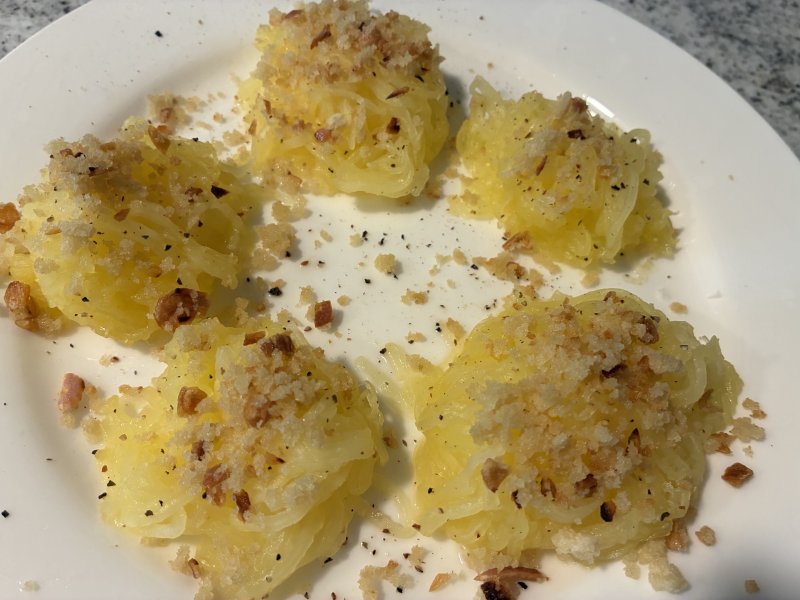Spaghetti squash can add fiber, subtract carbs in some dishes
Since I covered both summer squash and winter squash, it seems only fair to give some attention to a somewhat misunderstood vegetable, the spaghetti squash. Although its pedigree is as distinguished as its other cousins, spaghetti squash is mistakenly believed to have been invented in China. However, as a member of the Cucurbita pepo family, the original species of this squash is native to North and Central America.
But, there is a Chinese connection. During the middle 1800s, farmers in Manchuria bred a squash with desirable traits that were important for a specific culinary application. The squash was called “shark-fin gourd” because its stringy flesh was similar to the appearance of shredded shark fin. It could be used as an inexpensive replacement for the delicacy in shark-fin soup.
The yellow-skinned, pale-fleshed squash found its way to Japan around 1920, when it was brought to the Aichi Prefecture Agricultural Research Station. There, workers developed an improved variety that reached the international market in 1934 under the name Somen Nankin from the Sakata Seed Company. Soon thereafter, it arrived in the U.S., where the Burpee Seed Company sold it as “vegetable spaghetti.”
At the time of its introduction here, there wasn’t much interest in the new squash. However, when shortages in processed foods arose during World War II, enterprising home cooks turned to it as a replacement for dried noodles, separating the flesh of the baked squash into long, translucent strands that resembled angel-hair pasta. Without a strong vegetable flavor, the strands could be served under a spicy red sauce.
Today it is mostly used as a pasta replacement in low-calorie, high-fiber diets, as well as an interesting vegetable side dish seasoned with herbs. The chief complaint about spaghetti squash is that it can be too wet and mushy, nothing like al dente pasta. And, while it will never completely replace pasta, there are a few tricks to successfully serve it.
The first piece of advice is to ignore all the recipes that tell you to roast it whole or halved lengthwise. You will then have to deal with slippery seeds and lots of moisture. A better approach is to cut the squash horizontally into 1-inch rings and bake at a high temperature. This takes advantage of the fact that the strands form in a circular pattern, so you’ll get drier flesh and longer strands. Be careful not to overcook it, or you’ll have some messy mush.
The next step is to choose your sauce carefully. You can keep things simple with olive oil, herbs and Parmesan cheese, or consider bold flavors like pesto or brown butter sauces. Be sure to include a crunchy element, such as toasted bread crumbs or chopped nuts, so you don’t have a soft sauce on a soft vegetable.
The photo shows small “nests” of squash topped with butter, shallots and toasted breadcrumbs; you could add a sprinkle of crumbled feta cheese for more salty notes. Another option is to make a tomato sauce loaded with crumbled beef. It will readily absorb any excess moisture and provide a great contrast to the quiet flavor of the squash. Of course, grated Parmesan finishes the dish.
Spaghetti Squash Nests
Preheat oven to 400 F. Slice one inch from the top and bottom of squash; discard. Cut the squash horizontally into 2-inch-thick slices. Remove seeds from the center; arrange slices in a single layer on a rimmed baking sheet. Cook until softened, about 20 to 30 minutes. Allow to cool, then use a fork to pull the strands from each slice, forming them into a nest. Arrange nests on a serving plate. Melt butter over medium heat in a small skillet. Add shallot and sauté until lightly browned. Add breadcrumbs and cook until lightly toasted. Top each nest with breadcrumb mixture; season to taste with salt and pepper. Yield: 6 servings.
Spaghetti Squash & Tomato Sauce
Preheat oven to 400 F. Slice one inch from the top and bottom of squash; discard. Cut the squash horizontally into 2-inch-thick slices. Remove seeds from the center; arrange slices in a single layer on a rimmed baking sheet; drizzle with 1 T olive oil. Cook until softened, about 30 minutes. Dice the onion, mince the garlic and grate the carrot; set aside. In a large skillet, heat 2 T olive oil over medium high. Add meat and break apart into crumbles. Stir in vegetables, red pepper, salt and pepper to taste; cook until softened, about 5 minutes. Pour in crushed tomatoes; stir to combine thoroughly. Simmer for 15 minutes. Use a fork to pull out the strands of spaghetti squash. Transfer squash across four dinner plates. Top with sauce; garnish with fresh basil and parmesan cheese. Yield: 4 servings.























































